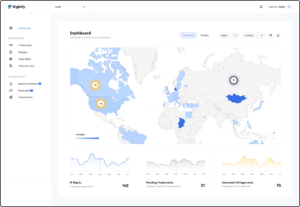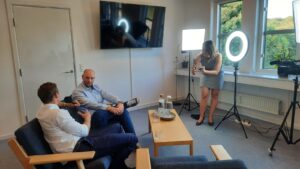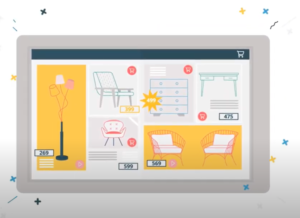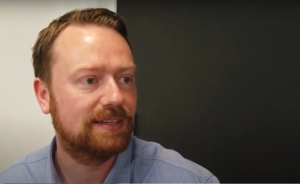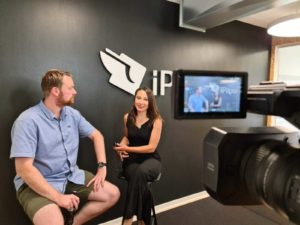The Digital Transformation Show [E1]: Video Microlearning, UX, Gamification And More About uQualio Platform
I could not think of a better guest to launch this Show! Kent Valentin Fallesen visited Aarhus last week and we took advantage of his trip from Copenhagen to Jutland to have a chat about uQualio.
Fallesen is the CEO of a micro-learning web-based platform that is disrupting the professional training industry.
Our discussion touched upon matters such as user experience and user-centred business approach, the origins and the journey of the company, the industries that are currently using his platform and the relevance of video and gamification in this e-learning trend called micro-learning.
Watch the first part of this interview or read the full transcription below.

The Digital Transformation Show - Episode 1: Kent Fallesen CEO at uQualio
I could not think of a better guest to launch this Show! Kent Valentin Fallesen visited Aarhus last week and we took advantage of his trip from Copenhagen to Jutland to have a chat about uQualio. Fallesen is the CEO of uQualio, a micro-learning web-based platform that is disrupting the professional training industry.
Our discussion touched upon matters such as user experience and user-centred business approach, the origins and the journey of the company, the industries that are currently using his platform and the relevance of video and gamification in this e-learning trend called micro-learning.
Watch the first part of this interview or read the full transcription below.
Estefanía Zárate Angarita (E): I understand that you come more or less often here… where are you based?
Kent Valentin Fallesen (K): I’m living close to Copenhagen but we also have our office in a small city called Veksø just outside or Ballerup, so it’s part of the Copenhagen area. I come quite often to Jutland because we have customers here that are interested in our system.
E: Kent, tell us a little bit about your company, give us an overview of what your company does.
K: We experienced that there is a rising need or demand for users of video as part of learning, and there’s been a trend in the U.S. for a certain time now, something called microlearning. The idea about microlearning is that you are using more bites of learning so it’s easier for people to understand and learn something very quickly, and video is perfect for that purpose.
So in our system, we have created something that is similar to, you can say, the course is similar to a playlist on YouTube, but the thing is that we’ve built logic over this so that is actually with a lot of learning functionalities, interactivity, gamification. And another thing which is quite different from YouTube is that you’re actually able to see who’s been watching your videos, whether they understood the videos and you’re able to communicate with them based on this.
I never talk badly about competitors but usually a lot of systems what they do is that they’ve been built for the companies that are using them and not for the learners or the users, and our idea has been since the beginning that we would like to make it great for both the admin users and the learners. So we started creating the actual learning module first and the idea is that is the person who’s taking a course that they have to be motivated so it’s them who are becoming qualified so… “You got qualifications, uQualio”.
E: I can hear that every time you talk about your company you go back to “the beginning” or “when we started”, so I would like to hear a bit more about the origins of the company and how long have you been in the market so far.
K: Actually the platform that we have now, we started developing it in 2015… We had also been doing similar things for some of the large corporations here in Denmark like Telia, where they needed to have retail training and customer service training. We had a very simple software program at that time.
Based on all the experience that we had we started developing this tool back in 2015, October 2015. In 2017 we got funding and we were able to really put a lot of effort and of course money into the system, so in January 2019 we were able to launch the full version with the subscription model and online payment.
Actually, the first customer we got on board was an American company that signed up for subscription directly on the platform. And this is kind of our idea. The tool, I have to say, is extremely inexpensive, so it is possible for even small and medium-sized companies to buy this tool and use it. So our target group is not large corporations as such, so we are not really doing traditional direct sales, is more online marketing that we are doing.
E: So from what I understand, this platform is cloud-based, what are the advantages of having a digital platform for e-learning – which we actually haven’t really mentioned the concept of “e-learning” and we will probably go a little bit deeper into it – what are the advantages for the company, having this digital platform that is cloud-based, where you don’t need to download anything?
K: Of course depends on the customer. Each customer is different, there can be different industries. Some companies, when they are selling through other companies, like distributors or resellers or agents and so on… they do not really have the names and emails of all those people all around the world. So this tool is perfect for them to train their sales partners in understanding their products, their value propositions, in objection-handling and so on.
But you can also use the tool of course for your own employees as onboarding, you can use it for your customers if they need to learn how to use your products… and this is the great thing, that it’s a responsive application, is web-based, browser-based, that you don’t have to download an app, you can use it from any device but you can also move from one device to another. And it has been built based on the newest technology so it’s token-based, so if you’ve been logged in you stay logged in.
So we’ve seen actually that for example some companies, for example, get increased sales by using it, some get increased customer satisfaction, some are getting more satisfied employees, more competent employees… so there are a lot of benefits to be reached.
I think one of the big differences between us and traditional systems is that we have this ability to include external employees, partner employees, people working in retail, if you want to let them know about your product, if you’re a wine manufacturer, maybe you would like the people in the store to know about your wine so if a customer comes in… and this becomes even more important now, talking about digital transformation because a lot of consumers they are nowadays sitting at home and then they are getting to know the product. If they go into the retail store and the sales crew doesn’t know anything about the product, they are not going to buy it then. (6:41) They have a hard time if they cannot advise them, they need to train the employees in the products if they want to have loyal customers.
E: I would like to hear a bit more about the customers because you’ve also been mentioning several industries like the retail industry, the sales industry… so, right now, who are the customers of uQualio so far?
K: This shows a little bit the strength of the system. We have manufacturers who are selling through retail, or who are selling through partners. Today we visited one of our customers, and we are not usually mentioning the name of our customers but their end customers are hospitals that are buying equipment from their partners, and they are selling globally through this partners.
We have also companies that are software platforms where they link from their software platform to our application so when the new features in the software need to be updated, they have a button, they click and then they go to our application and then all the training in how to use the new features or the first time they are going to use the software, then that’s available in our platform.
E: I would like to hear more about this GDPR situation that you’re kind of bringing a solution for, with your platform. How does this work?
K: We have a customer that is using our platform to train one of their customers in GDPR… I assume it isn’t what you mean but this is a perfect example because in our platform you can train people and then you can test them, that means you can show whether you’re compliant with this. So this is just an example of one of our customers who is using this to train in GDPR.
When it comes to ourselves, we have been through a long process of making sure that we are completely GDPR compliant.
E: Do you face some challenges when you go out to meet your customers and you’re explaining the advantages of the platform, and what they can get out of it and suddenly, do you need to explain very thoroughly what the advantages of it are or do you think in general, for the customers that you have already, there is a big understanding of why video is important and e-learning platforms are important? Or how these platforms like uQualio can bring, for example, some return of investment or – you were saying – customer satisfaction… Is this something that people are aware of or do you usually have to go into explanations on why this digital transformation platform is important for their companies?
K: I think again that a lot of the companies are different, and it’s different because they are different people so you cannot say that there is a specific type of customer. Video has become much more normal, it’s something very new and very normal to use, a lot of people are still feeling that is a big task to do this. Some are buying assistant from professionals but nowadays you can actually use your phone and start with it and you can actually edit the videos on your phone and then you can launch them. But learning is more than that, you have to set up learning goals for the courses, you have to have a learning goal for each video so you have to do some preparational work.
Some companies, they know they have to do it but it takes time for them to figure out how much time they actually can and how much they should invest in it. But as a comparison, if you have, let’s say, 200, let’s just say 20 sales partners around the world, if you want to make new product releases and inform about these products, it takes you a long time to travel around, it costs you a lot of money and, when you go there and train people, some people are sick, so you have to do it again. If you use e-learning like ours, it is always accessible, you can send it out to everybody at the same time, the cost is really really low, so the investment is that you have to create the videos, first of all. If you think about the environment, it’s also better that people are not travelling around in aeroplanes instead of just choosing a system like this.
Visit www.uqualio.com
